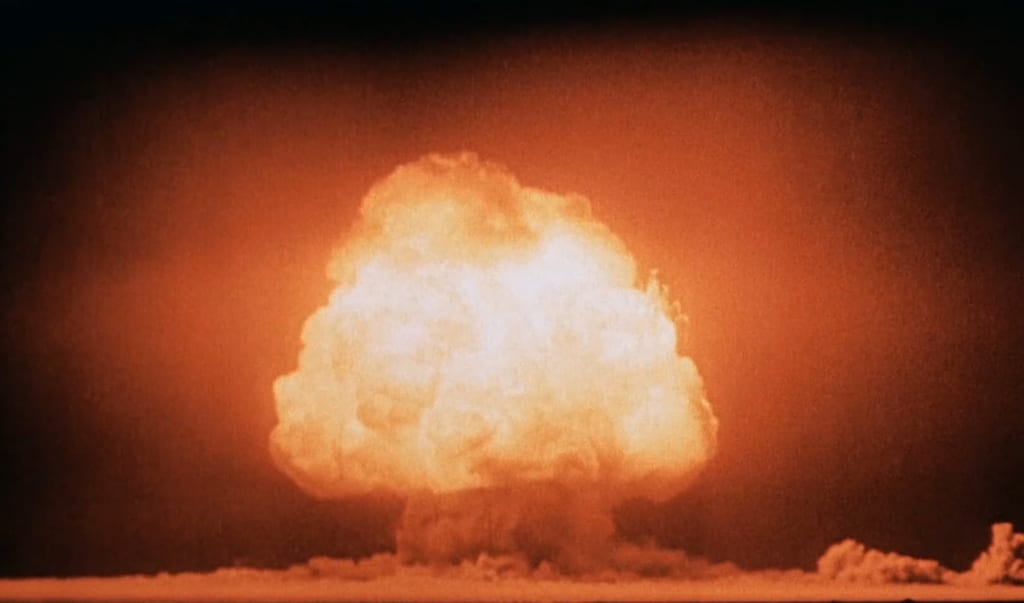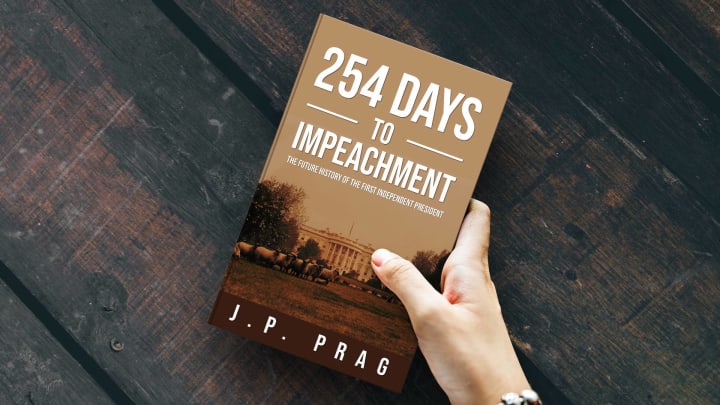
January 20th (Chicago, IL) – Perhaps for the first time since 2010 and reversing the nearly continuous downward spiral that began in 1995, the Doomsday Clock to nuclear disaster may be ticking backwards.
The Doomsday Clock is a metaphorical representation maintained by the Bulletin of Atomic Scientists that helps give a visual representation of how close humanity is to destroying itself—most notably from nuclear weapons. For instance, this has ranged from 17 minutes set in 1991 to just 100 seconds by 2020. The clock is not real-time and therefore does not change immediately no matter the situation in the world; not even during the Cuban Missile Crisis in 1962 nor when Russia started threatening to use any means necessary during its invasion of neighboring Ukraine in 2022. These events are arguably the closest the world has ever come to all-out thermonuclear war.
As such, the actions of the new President announcing the fourth of ten Executive Orders during the inauguration ceremony will not instantly set the clock rolling in one direction or another. However, the Bulletin was already expected to make their annual update in the coming days, so these pronouncements will definitely cause a significant recalculation. By press time, the Bulletin had not responded to any requests for comment.
In signing this particular Executive Order, the President did not simply declare a desire to reduce the available inventory of nuclear weapons at the disposal of the United States, but actually dictated specific commands for America to unilaterally disarm over 95% of its capabilities within four years. This would leave the entirety of the United States with around the same number of nuclear weapons as France or the United Kingdom, and indisputably result in Russia becoming the numeric leader in the atomic weapons field, followed distantly by China’s growing catalogue. Just knowing that these two countries would have far more armaments than the United States may then, counterintuitively, make the world closer to annihilation simply because the United States’ stockpile would not provide as much deterrence as it once did—a theory known as “mutually assured destruction” or “MAD”. The President’s political opponents highlighted those concerns in interviews and posts on social media following these announcements, especially in conjunction with the next two Executive Orders related to the United Nations and the deployment of American soldiers abroad that have further eroded global order.
See our follow-up coverage on these two Executive Orders on our homepage as both are rapidly developing stories.
Today, the United States has an inventory of over 5,500 nuclear weapons, although about 30% of those are considered “retired” and are in storage. Within the remaining arsenal, about 40% are readily available but are not attached to any delivery mechanism, while the remainder are able to be launched at any time. This means the United States has well over 1,600 nuclear weapons within its borders, stationed in other countries, and aboard various transports like ships and submarines that could be used at the press of a button.
This appears to be the President’s motivation in ordering a unilateral drawdown of these ordnances. While announcing this Executive Order during the Inauguration Ceremony, the President stated:
Studies have shown that a measly one hundred nuclear weapons would be more than enough to destroy the world as we know it. Uncontrollable climate change, nuclear winter, fallout for centuries—these are the least of the issues that the survivors of humanity, if there are any, would have to deal with. One hundred nuclear explosions are enough to crack the crust of the continents and assure that we have really broken the world. If so few nuclear weapons can do all of that, why do we have thousands? What is the point? What more could possibly be needed? dropping additional nuclear bombs is only going to prolong the Earth and humanity from ever bouncing back.
The International Campaign to Abolish Nuclear Weapons (ICAN)—which, according to its website, is “a coalition of non-governmental organizations” intent to see nuclear weapons banned worldwide—was quick to put out a statement in support of these actions, but also lamented that it was not nearly enough. Despite the explanation that the use of more than 100 nuclear devices worldwide would be devasting, the President’s Executive Order would actually bring America’s arsenal closer to 300 within four years. ICAN has made it clear that any nuclear cache is unacceptable and believes that having a single weapon is a violation of international law. A spokesperson for the organization in a press release stated:
Even a single nuclear bomb can kill untold millions and cause devastation for generations to come. To the newly installed President, using your own words, I ask: what is the point of having any?
Neither the President nor any member of the administration has responded to these statements directly. Instead, the White House pointed us back to the text of the original order where the intent to limit the number of nuclear weapons available to the United States at any given moment is specifically laid out. In order to accomplish this, there are two main actions that the Department of Defense (DOD) is to undertake. First, the DOD is to initiate a prioritization where they will list out all nuclear weapons and give them an order for decommissioning, from least important to most—including the ones that are intended to be maintained. This activity is supposed to wrap up within 90 days, at which the point the armaments will begin to be disassembled.
To further assist in this effort, the President has ordered that any nuclear weapon kept outside the United States must be returned to American soil within 180 days. It is unclear if this means weapons aboard ships and submarines in international waters, and the White House has not responded to requests for further clarification. It does appear, though, to cover nuclear missiles at American bases in foreign countries, including members of NATO. This would in particular affect places like Türkiye (formerly known as Turkey), where protests are ongoing due to an earlier pronouncement by the President condemning the Assyrian genocide.
Other NATO allies also host American nuclear weapons, notably Belgium, Germany, Italy, and the Netherlands. Although the Russian Federation claimed one of its chief reasons for the aforementioned invasion of Ukraine was concern over the further proliferation of nuclear arms to its borders or among NATO allies, that did not come to pass. This became a noteworthy focus when Finland—with its 1,340 km (830 mi) long border with Russia—ascended into full NATO membership following decades of neutrality in response to Russia’s aggression. Importantly, Finland is not a signatory to the United Nation’s Treaty on the Prohibition of Nuclear Weapons (TPNW) and has abstained from voting on resolutions in the U.N. General Assembly concerning it. Despite this, according to a 2019 study sponsored by ICAN, 84% of the Finnish population want to sign on to the treaty.
Similarly, most of the countries in NATO, the European Union, and Europe in general have continued a policy of not housing such destructive armaments. The ones that do, though, as well as the aforementioned United Kingdom and France that have their own, reacted with measured trepidation. Expressions of “regret” were common among those who responded, but there were no outright condemnations, save for Türkiye as it was lashing out for unrelated reasons. Still, sources have told us there were screaming matches between the front line security officials and their international counterparts, as well as frustration from those same civil servants due to being caught completely off guard without warning.
Hawkish members of Congress also expressed grave concern over potentially losing leverage and bargaining ability with America’s enemies and competitors. When asked about this aboard Air Force One en route to a still unannounced destination, the President said:
How can we tell other countries like Iran and North Korea not to make nukes when we have so many here? Unilateral action is simply the right thing to do. We will no longer use the threat of nuclear war as a bargaining chip with the likes of Russia and China and their proxies and similarly minded allies.
When told this response, one such Congressperson who wished to remain anonymous turned visibly red and shouted at our reporter:
How stupid can this President be? These countries will smell our weakness and come for us. This isn’t strength, it’s suicide!
It should be highlighted that Congress has not approved any funding for this project, not even the prioritization component. When asked about this, a spokesperson for the White House noted that as Commander-in-Chief, the President has wide discretion over the use of military funds. Congress had previously appropriated over $1 trillion to various military activities, much of which are nebulously vague. Due to this, the President feels assured that already allocated funds can be reprogrammed in a variety of ways.

The above piece is an excerpt from the speculative fiction novel 254 Days to Impeachment: The Future History of the First Independent President by J.P. Prag, available at booksellers worldwide.

Learn more about author J.P. Prag at www.jpprag.com.

254 Days to Impeachment is a work of mixed fiction and nonfiction elements. With the fiction elements, any names, characters, places, events, and incidents that bear any resemblance to reality is purely coincidental. For the nonfiction elements, no names have been changed, no characters invented, no events fabricated except for hypothetical situations.
About the Creator
J.P. Prag
J.P. Prag is the author of "Aestas ¤ The Yellow Balloon", "Compendium of Humanity's End", "254 Days to Impeachment", "Always Divided, Never United", "New & Improved: The United States of America", and more! Learn more at www.jpprag.com.






Comments
There are no comments for this story
Be the first to respond and start the conversation.